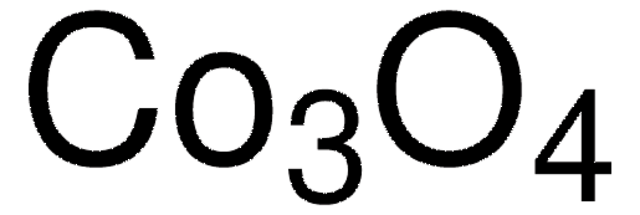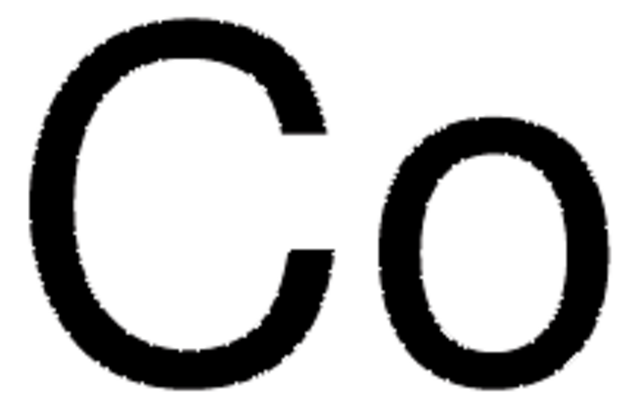221643
Cobalt(II,III) oxide
powder, <10 μm
Sinonimo/i:
Cobaltosic oxide, Tricobalt tetraoxide
About This Item
Prodotti consigliati
Stato
powder
Dimensione particelle
<10 μm
Punto di fusione
895 °C (dec.) (lit.)
Densità
6.11 g/mL at 25 °C (lit.)
applicazioni
battery manufacturing
Stringa SMILE
O=[Co].O=[Co]O[Co]=O
InChI
1S/3Co.4O
LBFUKZWYPLNNJC-UHFFFAOYSA-N
Cerchi prodotti simili? Visita Guida al confronto tra prodotti
Descrizione generale
Applicazioni
- Synthesis of diphenylalanine/cobalt oxide hybrid nanowires and their application to energy storage.: This study demonstrates the synthesis of hybrid nanowires using diphenylalanine and cobalt oxide, highlighting their potential for enhancing energy storage capacities (Ryu et al., 2010).
Avvertenze
Danger
Indicazioni di pericolo
Consigli di prudenza
Classi di pericolo
Aquatic Chronic 3 - Carc. 1A Inhalation - Resp. Sens. 1
Codice della classe di stoccaggio
6.1C - Combustible acute toxic Cat.3 / toxic compounds or compounds which causing chronic effects
Classe di pericolosità dell'acqua (WGK)
WGK 1
Punto d’infiammabilità (°F)
Not applicable
Punto d’infiammabilità (°C)
Not applicable
Scegli una delle versioni più recenti:
Possiedi già questo prodotto?
I documenti relativi ai prodotti acquistati recentemente sono disponibili nell’Archivio dei documenti.
I clienti hanno visto anche
Articoli
Magnetism and magnetic materials have been of scientific interest for over 1,000 years. More recently, fundamental investigations have focused on exploring the various types of magnetic materials and understanding the magnetic effects created by electric currents.
Magnetic materials permeate numerous daily activities in our lives. They are essential components of a diversity of products including hard drives that reliably store information on our computers, decorative magnets that keep the shopping list attached to the refrigerator door, electric bicycles that speed our commute to work, as well as wind turbines for conversion of wind energy to electrical power.
Il team dei nostri ricercatori vanta grande esperienza in tutte le aree della ricerca quali Life Science, scienza dei materiali, sintesi chimica, cromatografia, discipline analitiche, ecc..
Contatta l'Assistenza Tecnica.









